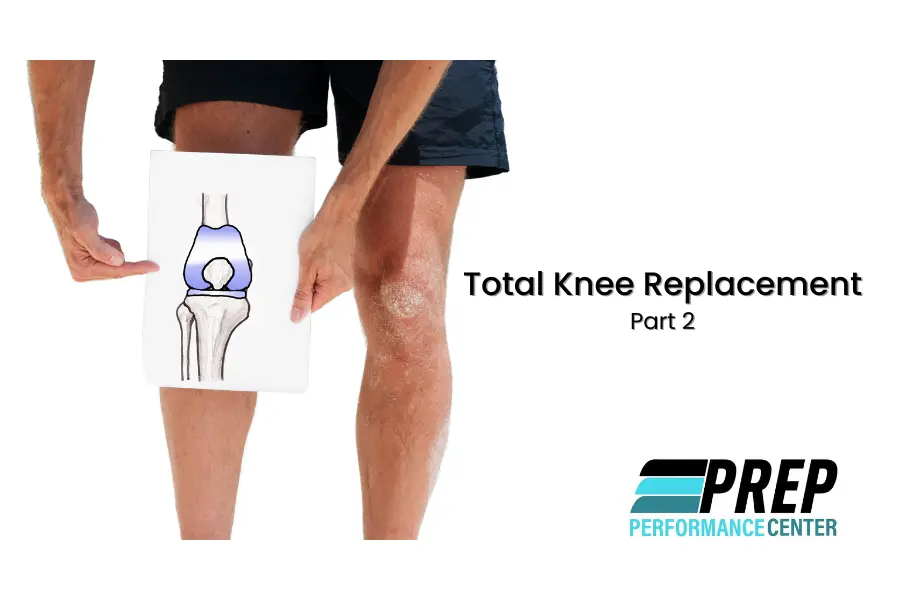Phase I – Post Surgical Phase (Day 0-3): (Total Knee Replacement)
The first few days after your Total Knee Replacement (TKR) is crucial in meeting your range of motion and mobility goals. You might be wondering when will my knee stop hurting, when can I do stairs, when can I shower, and how I bend my knee after Total Knee Replacement. In this article, we will give you a step-by-step program that has worked for many of our patients in our clinic.
You probably didn’t expect it, but they don’t give you much time to rest and recover after your total knee replacement. Your Physical Therapist is often in your room the following day asking you to bend your knee, stand up, walk to the bathroom and maybe even go up and down the stairs. You might be walking with a cane or a walker at this point. Pain is definitely to be expected but tolerable.
Goals:
Reduce swelling, increase range of motion, increase functional strength during daily activities
BASIC Home Exercise Program (Complete 3-4 times per day, approx. 10-15min)
– Walk 1x/hour (Make a loop on your first floor and aim to complete 2-3 times per hour)
– Heel slide
– Assisted Heel Slide
– Quad Set with towel
– Straight leg raises (SLR)
Progressive Home Exercise Program (Complete 10 reps 1x/day near countertop for safety)
Complete these exercise with assistance from a family member for safety reasons
– Standing Hip ABD
– Standing Hip EXT
– Standing Heel Raises
– Standing Toe Raises
– Standing Marching
– Standing Knee Flexion
– Stairs 1x/day
– Sit to stand
– Seated Heel Slides
– Seated Knee Extension
– Seated Marching
A few secrets that no one ever tells you (Total Knee Replacement)
– Wear a compression sleeve or ace wrap around your knee for a few weeks. Managing your swelling is a big part of helping you bend your knee and straighten your knee. Swelling can also contribute to pain, possibly causing fear of bending your knee, quadricep inhibition and stagnation in progress. Start below your knee at mid calf level and apply moderate compression at the calf and slowly reduce the amount of tension as you move up towards the hip. Try to avoid bumps in the ace wrap.
– Effleurage. Seems silly, but the more you manage you touch your knee the less sensitive and painful it becomes. You want to perform a gentle massage to your surgical knee that helps with lymphatic drainage and mobilizing the swelling surrounding your knee. Starting from below your knee and moving up towards your hip, you will assist your body in flushing the swelling and mobilizing surrounding tissue. Check out our video here.
– Follow the BUM Principle. Be Up and Moving- I promise you want to move once an hour. Movement , while painful, will also help manage the swelling which in turn improves range of motion and overall mobility and independence.
– Don’t do too much. While we want you up and moving, you also want to give yourself a break and elevate and ice your knee (above your heart) for 20 min a few times a day. This manages swelling and pain and again just keeps you moving towards your goals.
– Pain Meds. DEFINITELY stay on top of your pain medications. Set an alarm and take those pain meds! In order to make the gains you want, you have to control your pain.
– Listen to your body. Be aware of how your knee feels. Pain is to be expected. But if you follow this program and stay active (but not TOO active), bending and straightening your knee will be painful BUT TOLERABLE.
Last but not least, if you haven’t already, you will want to schedule your Outpatient Physical Therapy Evaluation for approx. 1-2 weeks after your surgery. Your surgeon will likely tell you when to start outpatient physical therapy, but the sooner the better. Choosing a Doctor of Physical Therapy with experience in treating patients with Total Knee Replacements is very important. You want a therapist who is going to push you to meet your goals, but empathetic and approachable when things might not go according to plan.
You are probably going to receive In-home therapy for a week or two, which focuses on safety and independent mobility within your house, where outpatient therapy focuses on progressing your Range of Motion, normalizing your gait mechanics, improving your strength to go up and down stairs, and return to other activities of daily living. Goals of outpatient therapy are to normalize knee range of motion, reduce pain, improve strength and ability to complete health and wellness activities as you did prior to surgery.
Check out our Total Knee Replacement Part 3 blog that will help you as you progress into the next phase of rehab.
Download our Knee Range of Motion Tracker, FAQ Page and Return to Sport Timeline.
Disclaimer: This is not medical advice. Always reach out to your medical provider with questions and if you are worried at all about an infection, go to Immediate Care.
Read more article: Headaches


